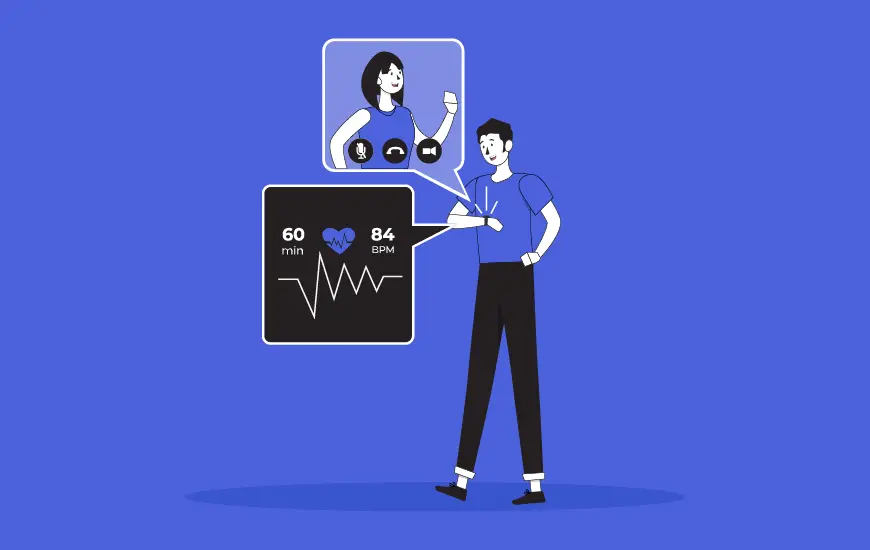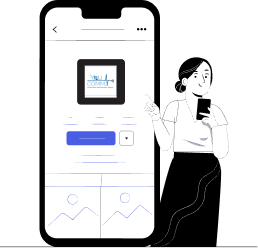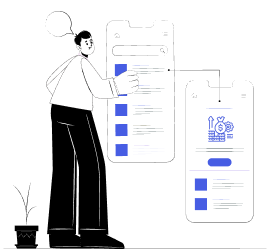- A Quick Glance at the Wearable App Market
- How Wearable App Development Differs From Standard Mobile App Development
- Types of On-Demand Wearable Apps and Devices
- Smartwatches
- Fitness bands
- Head-mounted displays
- Smart Jewelry
- Smart Eyewear
- Remarkable Benefits of Wearable App Development
- Enhanced User Engagement
- Improved Health and Wellness
- Increased Convenience
- Valuable Health Insights
- Seamless Integration with IoT
- Industry-Wise Applications of Wearable App Development
- Retail and eCommerce
- FinTech
- Healthcare
- Manufacturing & Logistics
- Gaming
- Fitness and Sports
- Education
- Features for Wearable App Development: Enhancing Product Performance
- Real-Time Monitoring and Data Syncing
- Health and Fitness Tracking
- Battery Efficiency
- Gesture Control
- Connectivity with Other Devices
- Voice Commands
- Security and Privacy
- Notifications and Alerts
- Customization Options
- Planning Your Wearable App: How To Get Started
- 1. Brainstorming
- 2. Collecting Data
- 3. Project Planning Checklist
- Considerable Factors for Wearable App Development
- 1. App Complexity
- 2. User Base
- 3. Data Security
- 4. Seamless Integration
- 5. Prototyping and UX Optimization
- 6. Glanceability
- 7. Context Awareness
- 8. Cross-Device Compatibility
- Wearable App Development Process – A Step-by-Step Guide
- Ideate and Conceptualize Your App
- Conduct Market and Competitor Analysis
- Choose the Type of Wearable App Development
- Outline Key Features and Functionalities
- Choose the Right Development Partner
- Craft Intuitive UI/UX Design for Wearables
- Select the Ideal Technology Stack
- Build and Develop the App
- Test and Launch the App
- Monitor and Maintain
- How Much Does It Cost To Build a Wearable App?
- 1. Limited Screen Space
- 2. Battery Consumption
- 3. Multi-Device Compatibility
- 4. Data Security and Privacy Risks
- What is the Future of Wearable App Development?
- How Can Appinventiv Help You With Wearable App Development?
- FAQs
When Google acquired Fitbit for $2.1 billion in 2021, it was not just buying a fitness tracker but investing in a thriving ecosystem powered by wearable apps. Fitbit’s success was not just about hardware; its app’s ability to deliver real-time health insights, sync seamlessly with multiple devices, and engage users with personalized recommendations made it a game-changer.
Similarly, Apple’s wearable ecosystem, particularly the Apple Watch and Health App, has contributed to over $41 billion in revenue, proving that wearable technology is more than just a trend but a business growth engine.
These success stories exemplify businesses that opt for wearable app development, which can unlock new revenue streams, enhance user engagement, and offer highly personalized experiences. Whether health monitoring, fitness tracking, smart notifications, or productivity enhancements, wearable apps have penetrated everyday customer’s lives. This is why the number of wearable devices like smartwatches, fitness trackers, smart glasses, health monitors, etc., has soared in recent years.
According to Statista, the global market of wearable devices is projected to record shipments of over 563 million devices in 2025, with this value set to reach 612+ million by 2028.
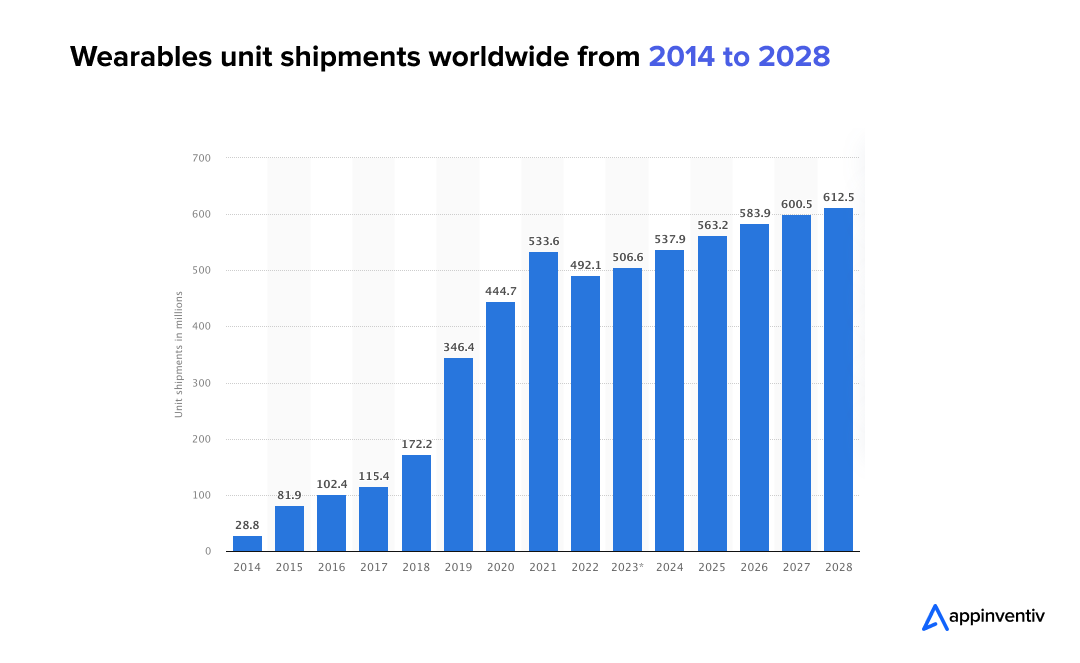
This increasing penetration of wearables in modern consumers’ lives presents a lucrative opportunity for businesses to opt for wearable app development.
However, wearable application development comes with its own set of challenges. Limited screen space demands intuitive UI/UX design, battery constraints require efficient power management, and real-time data processing requires strong security measures. So, understanding the development process is crucial if you are looking to build a next-gen wearable app.
This guide explores everything you need to know, from available types, benefits, core features, applications, and the development process to market opportunities and estimated costs. So, let’s begin by looking at the current market standing of wearable technology and apps.
A Quick Glance at the Wearable App Market
The wearable technology market is experiencing exponential growth, driven by increasing consumer adoption and advancements in connectivity. The following statistics highlight wearable app development’s rising demand and potential across industries.
- The global wearable technology market is rapidly growing, with over 1 billion connected wearable devices already in use.
- The wearable technology market is anticipated to be valued at 265.4 billion by 2026, growing at a CAGR of 18% from 2021-2026.
- Smartwatches lead the market with a 43% share among wearable devices.
- Healthcare and fitness sectors contribute approximately 60% of total wearable tech revenue.
- 29% of global consumers own at least one wearable gadget as of 2024. 40% of users consider wearable devices indispensable, while 25% wear them while sleeping.
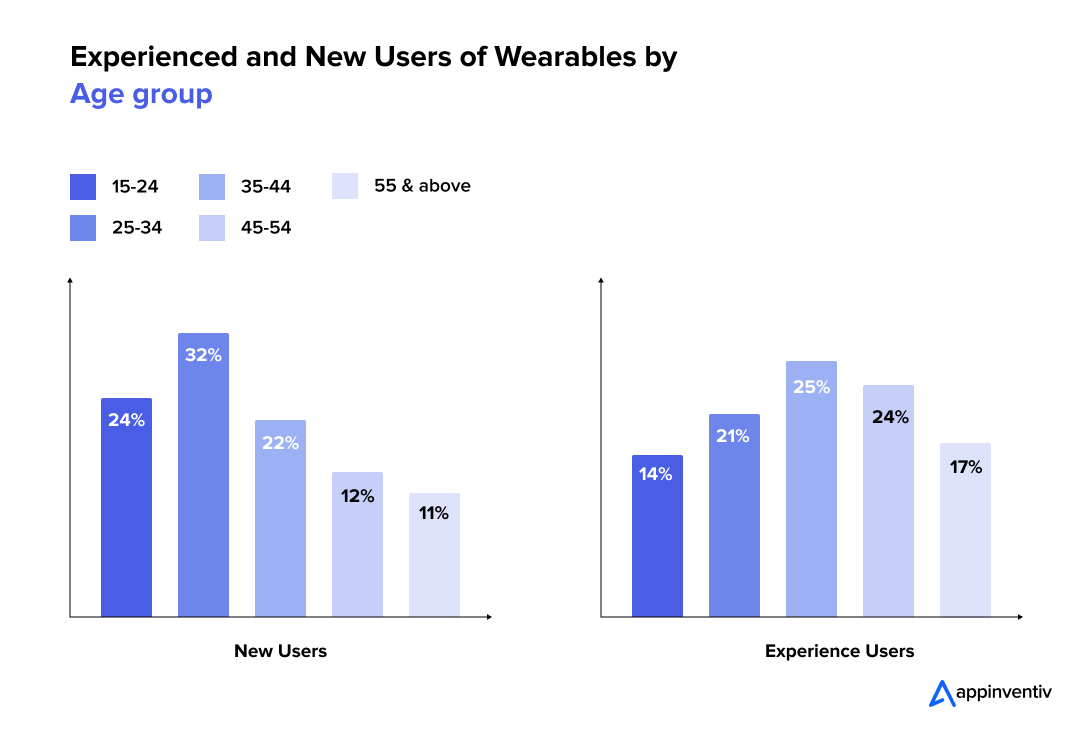
Impressive? So, why not capitalize on this rapid wearable boom? Whether stepping into the digital space for the first time or enhancing your existing presence, this data exemplifies that investing in wearable application development will always be a profitable venture to help you create impactful customer experiences and propel your business forward.
Now, let’s discuss how wearable app development differs from regular mobile app development.
How Wearable App Development Differs From Standard Mobile App Development
A wearable app specifically functions for wearable devices such as fitness trackers, smartwatches, smart glasses, etc, to track real-time information in sync with Bluetooth or Wi-Fi. Unlike standard mobile apps, wearable apps are built with a customized interface optimized for smaller screens and limited hardware capabilities, ensuring seamless performance on compact, lightweight devices.
What else? Here’s how mobile apps differ from wearable apps:
| Wearable Apps | Standard Mobile Apps |
|---|---|
| The functionality of wearable apps is limited due to small and less powerful hardware | A diverse range of features and functionalities as per the business needs |
| Designed to communicate with apps present in the mobile device and typically needs both to execute the intended task | Designed to function independently on Android, iOS, or cross-platform frameworks. |
| Minimal user inputs and interaction are required to perform | High user interaction is required to perform various tasks, including calling, streaming and more |
| Device-specific APIs restrict cross-platform compatibility. | Developed on any operating system and platform. |
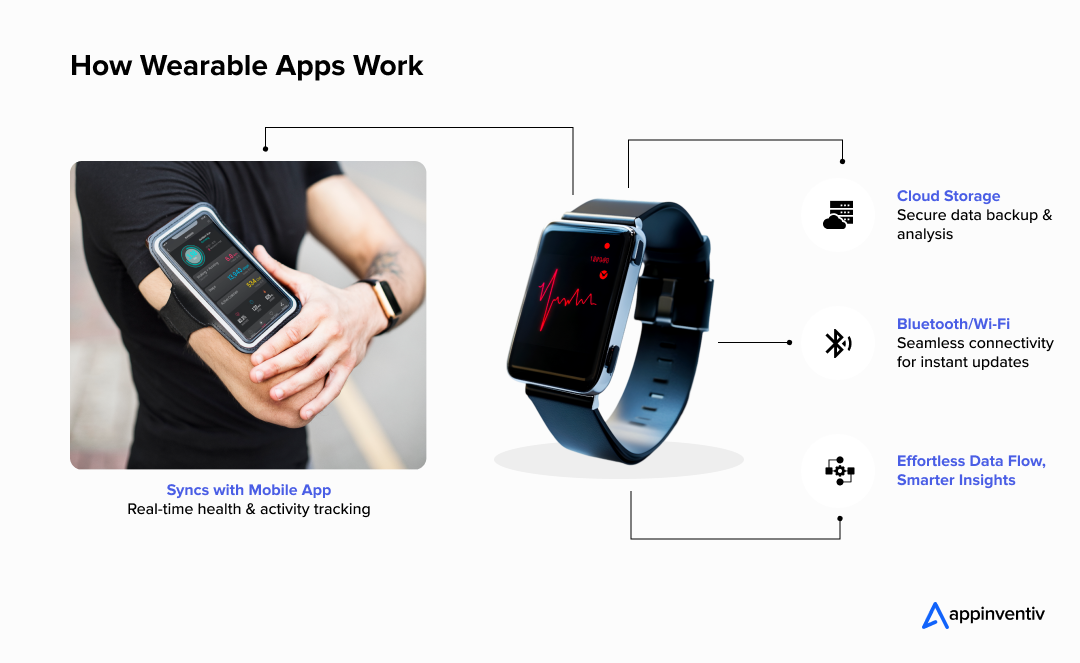
Even if user interaction is limited, wearable app development presents a promising market for businesses looking to connect with their customers on a personal level. With a significant user base relying on various on-demand wearable apps, let’s explore the different types of wearable devices currently available.
Types of On-Demand Wearable Apps and Devices
Functional on IoT connectivity, wearable technology has expanded beyond smartwatches and fitness trackers. The popular wearable app development trends cater to modern consumers and industries with specialized applications. Speaking of trends, here is a comprehensive list of the most prominent types of wearable app development that will never run off style and usage:
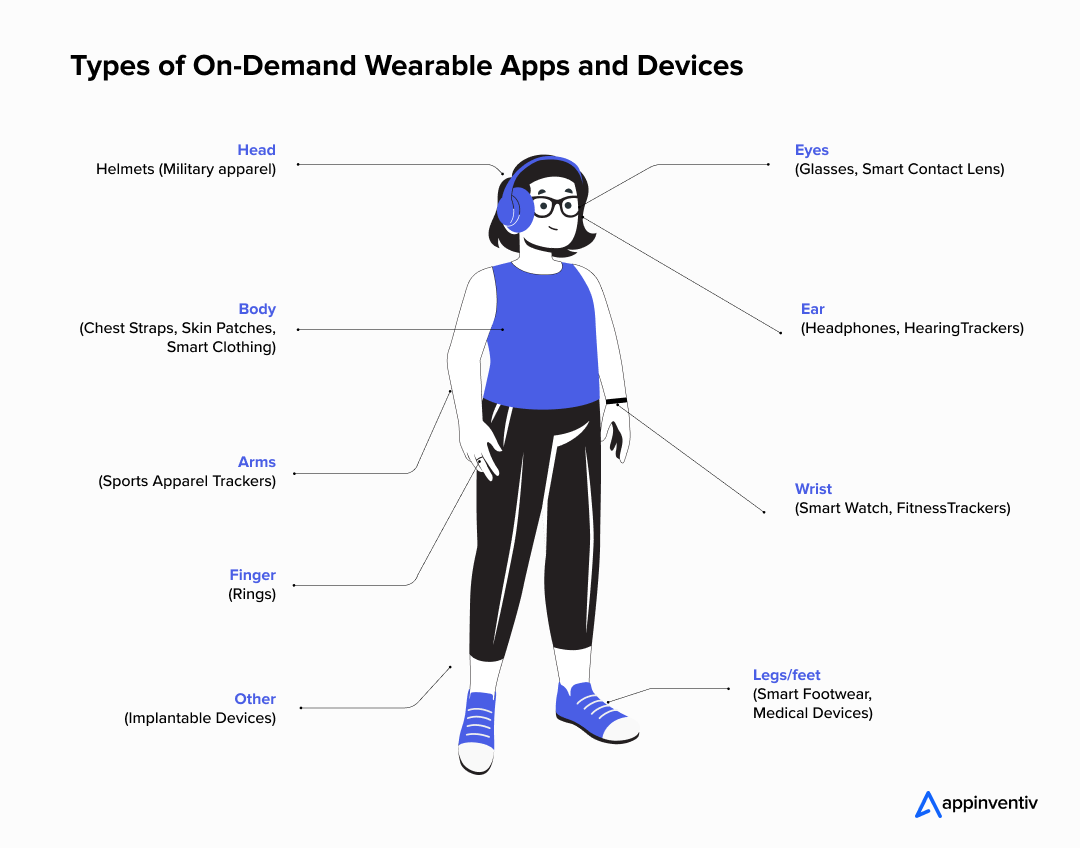
Smartwatches
According to Statista, smartwatches are the most popular type of wearable device, expected to grow to over 402 million by 2026. This wearable device allows users to leverage several features, including pedometers, physical activity trackers, notifications, etc. Smartwatches include sensor-related functions that enhance the user experience and make their associated app innovative and feature-rich.
Examples: Apple Watch, Samsung Galaxy Watch, Fitbit, etc.
Key features of smartwatch:
- Heart rate monitor
- Calorie and activity tracker
- SpO2 monitoring
- ECH and ECG app function
Fitness bands
Fitness bands are ideal for fitness enthusiasts to track their everyday activities and movements. This wearable app device collects all information related to physical activity, heart rate, sleep patterns, etc., and shares detailed insights.
Examples: Fitbit Charge, Garmin Vivosmart, Xiaomi Mi Band
Key features of fitness bands:
- Health metric
- Breathing rate
- Oxygen saturation monitoring and more
Head-mounted displays
Head-mounted displays (HMDs), including AR and VR glasses, are among the most advanced wearable devices. These wearables provide users with immersive experiences by overlaying digital information onto their surroundings or transporting them into a fully virtual environment. They are widely used for gaming, training, remote assistance, and industrial applications.
Examples: Microsoft HoloLens 2, Meta Quest 3
Key features of head-mounted displays:
- Hand and voice controls
- Eye and motion tracking
- Real-time data overlay
Also Read: AR/VR and wearables trend predictions for the coming years
Smart Jewelry
Smart jewelry combines fashion with functionality, offering discreet yet powerful wearable technology. Smart rings, bracelets, and necklaces are among the most popular smart jewelry devices, designed to track health metrics, notify users of alerts, and integrate seamlessly with smartphones.
Examples: Oura Ring, Bellabeat Leaf, Ringly Smart Jewelry
Key features of smart jewelry
- Health and fitness tracking
- Stylish and minimalist design
- Smart notifications
Smart Eyewear
Smart glasses or eyewear are the next big technological benefits of wearable devices that integrate data associated with the object the user visualizes. Smart glasses collect information from internal and external sensors along with supporting wireless technologies such as Bluetooth, GPS, and WiFi.
Examples: Google Glass, Ray-Ban Meta Smart Glasses, Lucyd Eyewear
Key features of smart eyewear:
- Information assessing
- Visual tracking
- Data storage and communication
Remarkable Benefits of Wearable App Development
Wearable app development benefits businesses in various ways that help transform user experiences and drive operational growth. Here are some of the head-turning benefits of wearable app development:
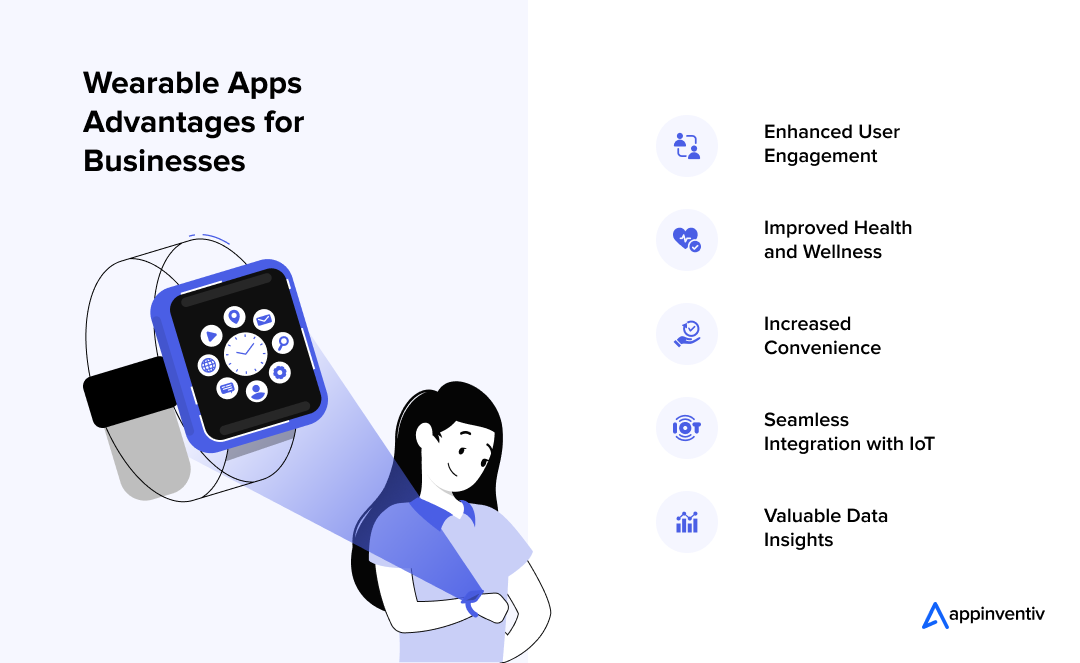
Enhanced User Engagement
Wearable apps provide real-time, engaging, informative, and personalized interactions that keep users connected and engaged throughout their day. For instance, fitness trackers monitor daily activities, providing immediate feedback and motivation. This continuous interaction enriches the user experience and encourages long-term commitment to the application.
Improved Health and Wellness
From fitness trackers to medical monitors, wearable apps continuously monitor wearers’ health metrics like sleep quality, step count, heart rate, etc. This helps users manage their wellness proactively. This constant monitoring enables early detection of potential health issues, allowing users to manage their wellness proactively and take timely action in the case of emergencies.
For example, a life-saving incident occurred in 2024 when an elderly woman’s Apple Watch Series 10 detected and notified her about atrial fibrillation (AFib) through its ECG feature. This timely alert prompted her to seek immediate medical attention. This highlights the significant impact of wearable technology in early detection and preventive healthcare.
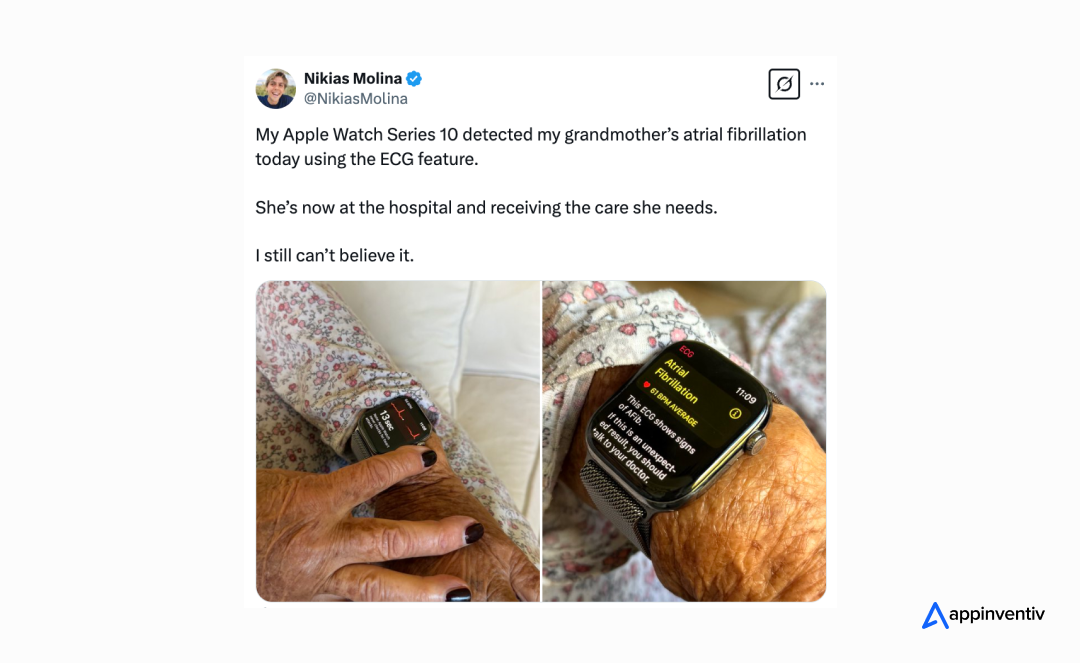
Increased Convenience
With on-the-go accessibility, wearables deliver critical information and notifications directly to users’ devices like smartwatches, eliminating the need to check their smartphones constantly. This hands-free accessibility enhances productivity and ensures vital information is always within reach.
Valuable Health Insights
These apps collect real-time health data, empowering users with deeper insights into their well-being. Tracking patterns and trends allows individuals to make informed decisions, adopt healthier habits, and receive more personalized healthcare recommendations. This helps enhance their overall well-being and experience.
Seamless Integration with IoT
Wearable technology easily integrates with other smart devices, creating an interconnected ecosystem that enhances user experience. For example, a wearable health monitor can communicate with smart home devices to adjust environmental settings based on the user’s health data. This level of integration provides personalized and automated responses to individual needs, thus enhancing the user experiences.

Industry-Wise Applications of Wearable App Development
As the demand for smart wearables grows, industries are finding innovative ways to integrate these devices into their operations, unlocking new opportunities for growth and digital transformation. Wearable technology in enterprise apps has already redefined different sectors with features like real-time data tracking, seamless connectivity, etc.
From healthcare and fitness to retail and manufacturing, businesses are leveraging wearable app development to improve efficiency, productivity, and customer engagement. Let’s look at the sectors successfully leveraging the benefits of wearable app development.
Retail and eCommerce
Wearable app development in retail and eCommerce helps enhance customer experience and streamline operations. Smart glasses help warehouse staff navigate the inventory, while wearable apparel like hand gloves, jackets, etc., ensure the user’s or wearer’s safety. Moreover, retailers use smartwatches and wearables to offer personalized shopping experiences and real-time notifications.
Real-World Example: Amazon uses smart glasses and wearable scanners to streamline inventory management and improve warehouse order-picking accuracy.
FinTech
Wearable app development is also highly utilized by the FinTech and insurance sectors, enabling seamless contactless payments and real-time transaction alerts. For instance, smartwatches with NFC sensors allow users to make payments directly from their wrists while offering fraud alerts and balance checks.
Real-World Example: Apple Pay and Google Pay are the two most popular payment apps based on wearable application development.
Healthcare
Healthcare wearable app development is revolutionizing the sector by enabling real-time patient monitoring, chronic disease management, and remote diagnostics. For instance, wearable devices like smartwatches and biosensors track heart rate, oxygen levels, and glucose levels, providing critical data for healthcare professionals and empowering patients to take precautionary measures at home by keeping track of their health details.
Real-World Example: The Apple Watch detects irregular heart rhythms, helping users identify potential cardiac issues early.
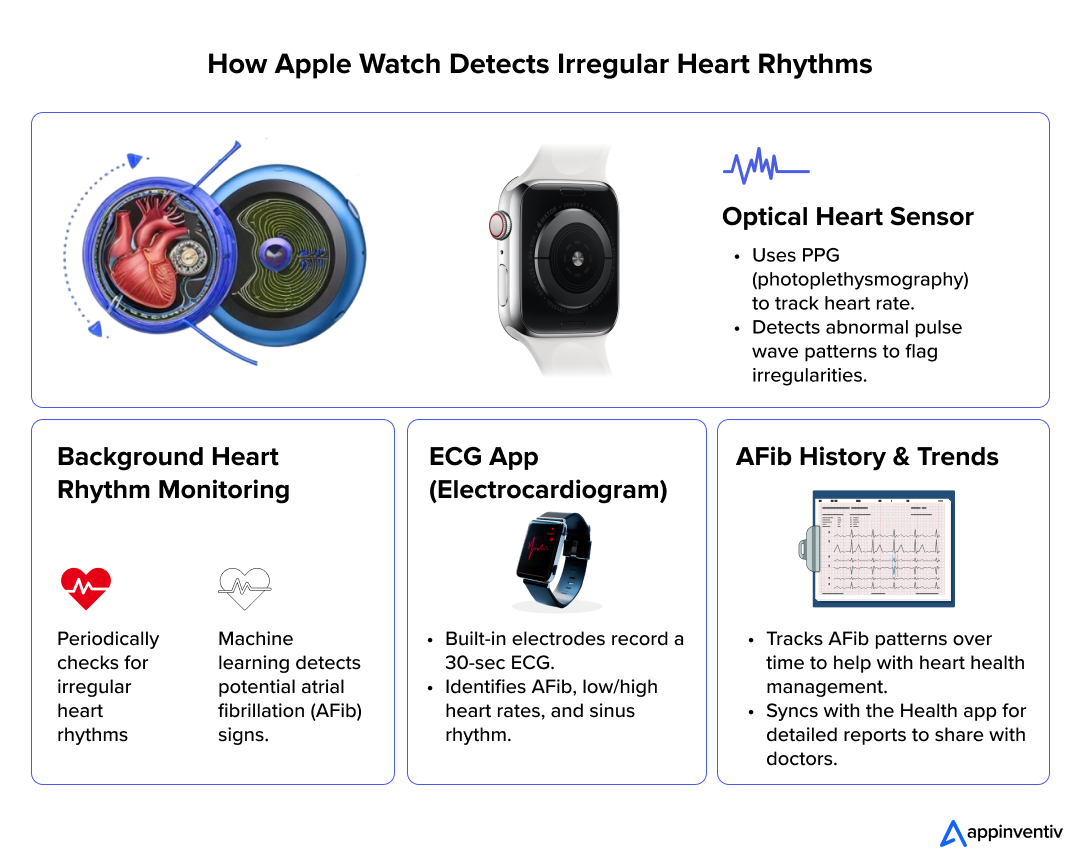
Manufacturing & Logistics
Wearable apps enhance safety, efficiency, and productivity in the industrial environments of the manufacturing and logistics industries. For instance, smart helmets and AR glasses provide hands-free access to blueprints and real-time equipment diagnostics.
Real-World Example: Boeing uses AR-powered smart glasses to assist engineers in assembling complex aircraft components with higher accuracy.
Gaming
With AI-enhancing wearables, gaming devices have garnered more user engagement. With the release of smart glasses and VR headsets, more and more users have started showing interest in AI-backed gaming. Therefore, wearable devices and gaming are often at a symbiotic linear rate with the common goal of giving the target audience an interrupted and immersive AI-driven experience.
Real-World Example: Vive Trackers by HTC track movement and provide real-time feedback for VR gaming. When paired with VR gaming apps, they enhance the immersive experience by allowing players to move and interact within virtual environments.
Fitness and Sports
Body-mounted AI wearable devices can successfully provide complete fitness information to their users with voice assistants and real-time insights. Besides, AI-enabled Bluetooth devices in the form of fitness trackers are now featured with biosensors. These biosensors detect elevation, heart rate, proximity, motion, and touch.
Real-World Example: Fitbit, Strava, and Nike+ are some of the most popular examples of wearable app development for the fitness and sports industry that provides data on steps, heart rate, sleep patterns, and physical activity, helping users monitor their health and fitness levels in real-time
You may like reading: 15 Features That Could Make Your Fitness App Popular like Fitbit.
Education
There is a huge advancement in the field of education when it comes to learning virtually. Thanks to AR/VR trends and wearable application development. Wearable devices like Google Glass help with the detailed anatomy of objects, data, and other crucial information. Wearables have also been extremely useful in studying small molecules and exploring virtual dimensions for research purposes. They can also record sessions, capture photos, and do a lot more.
Real-World Example: Microsoft HoloLens is an AR headset used in educational environments for hands-on learning, enabling students to visualize complex subjects like anatomy or chemistry in 3D.
Apart from these applications, wearable apps are efficiently leveraged by digital businesses that support social media, map navigation, and more.
Also Read: Wearable AI: implementation in the digital world.
Features for Wearable App Development: Enhancing Product Performance
When it comes to wearable app development, the app’s success largely depends on the features integrated into the product. Wearables are expected to offer both functionality and interactive user experiences. Keeping this in mind, here are some key features of wearable app development that can significantly enhance product performance and propel your business forward:
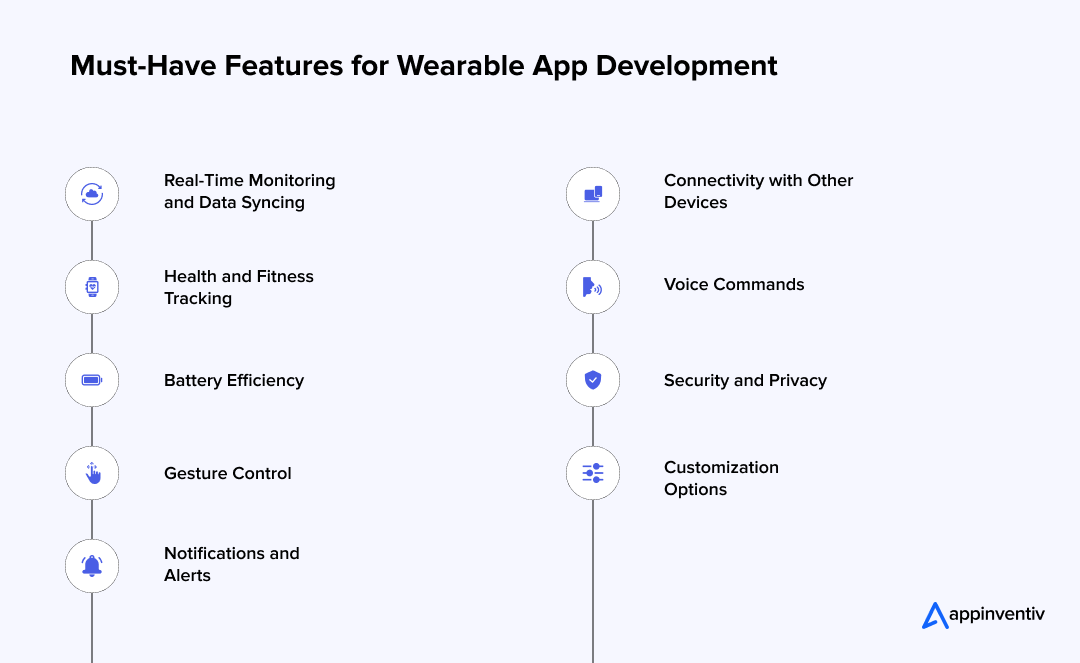
Real-Time Monitoring and Data Syncing
Wearable apps must continuously monitor user activity, health metrics, or environmental conditions and sync this data in real-time with the user’s device. This ensures that users receive up-to-date information, whether heart rate, steps taken, or burned calories.
Health and Fitness Tracking
This is one of the most integral features of wearable app development that helps users track fitness and health data, such as heart rate, oxygen levels, sleep patterns, and calories burned. These days, users prefer healthier lifestyles, and this feature successfully serves this purpose.
Battery Efficiency
A wearable device’s battery life is crucial to user satisfaction. App developers must ensure that the app is designed to minimize battery usage, allowing wearables to function longer without frequent recharging.
Gesture Control
Many wearables come with the capability to track gestures, such as swiping or tapping. Integrating gesture-based control in the app can enhance user interaction. This will enable them to easily perform tasks, like accepting calls, changing music, making payments, or starting a workout.

Connectivity with Other Devices
Wearable apps should seamlessly sync with mobile devices and other IoT devices in healthcare. This allows users to access the app on various platforms from anywhere. Whether it’s syncing health data with a smartphone or sending updates to a smart home system, connectivity across multiple wearable development platforms is a must.
Voice Commands
With the growing integration of AI assistants like Siri, Google Assistant, and Alexa, wearable apps must have a voice command feature. This hands-free interaction improves the user experience, especially when on the go or performing physical activities.
Bonus Read: Cost of developing an AI voice app like Speechify
Security and Privacy
As wearable devices gather sensitive data, ensuring privacy and security is paramount. Features like biometric authentication (fingerprint or facial recognition) and encrypted data transfer will help secure users’ personal and health information.
Notifications and Alerts
Notifications are one of the main functionalities of wearable apps. Push notifications and alerts inform users about important updates, from incoming messages and emails to health alerts such as abnormal heart rate or low oxygen levels.

Customization Options
Providing users with the ability to customize their wearable app experience, such as adjusting settings, choosing data metrics, or changing the interface, is also a vital feature for wearable application development. This enhances the app’s usability and appeal.
Planning Your Wearable App: How To Get Started
Wearable app development is the most fascinating yet frustrating technology at the same time. Apart from coding and circuit design, there are several other things that you need to consider before starting to build your wearable device apps. The task of brainstorming, getting a clear idea about the type of app you want, the kinds of components you want to include, and so forth, are some of the planning ideas that need to be clear.
Let’s discuss and know how to plan properly for smooth execution.
1. Brainstorming
Before starting any project, you need an idea, a plan of how to do it, what to include, and so on. Thus, start by making a rough outline of your app and include what it should do, how it should look, what to include, and most importantly, what mistakes to avoid when launching a wearable app.
Since we are just mapping out the possibilities and functionalities that should be there at this phase, you are free to use your imagination and preferred method of placing the ideas.
2. Collecting Data
Wearable app devices rely on data to improve their functionalities and provide accurate information to the user. However, to offer true value, the app must understand the context in which the data is collected. The collected data could be misinterpreted without this context, leading to inaccurate results. Therefore, to ensure precision, developing app sensors specifically for Android Wear apps, iOS smartwatches, and other wearable devices is essential.
3. Project Planning Checklist
Make a proper mobile app development checklist of questions while declaring the specifics of your project. Consider questions such as how durable the project needs to be, whether you want to make the circuit transparent, who the target audience will be, functionalities to increase user engagement, whether the app will be developed for Android or iOS, and so on.
These questions help clarify the project’s scope and development process, including the type of device to be created.
Considerable Factors for Wearable App Development
Developing a wearable app requires a strategic approach that balances device compatibility, functionality, and user experience. With the growing demand for wearables in industries like healthcare, fitness, and fintech, it is essential to address critical factors that impact performance, usability, and security. From selecting the right platform to optimizing integration and data protection, here’s what you need to focus on when building a successful wearable app.

1. App Complexity
Unlike smartphones, wearable devices are designed for direct interactions rather than handling complex computational tasks. Given their limited processing power, it’s crucial to determine which app functionalities should be included in the wearable interface and which should remain on the connected smartphone or cloud service.
2. User Base
Since the user base is different for smartphones and wearables, the wearables app development will also be different accordingly. Therefore, it is important to understand and know for whom the app is being developed, what kind of app is created according to the demographic, and what necessary changes need to be made. Wearable app developers must align app functionalities with user demographics to ensure relevance and usability.
3. Data Security
Data collected from wearables is extremely critical as the information is sensitive according to the person’s location, health information, likes, dislikes, habits, etc. Thus, wearable app developers must use strong security measures like data encryption techniques, secure authentication mechanisms, and compliance with data protection regulations to maintain user trust and prevent data breaches.
4. Seamless Integration
Wearable apps should integrate effortlessly with connected devices and platforms to provide a unified experience. Successful integration requires carefully selecting data points, leveraging System-on-a-Chip (SoC) solutions, and using APIs to enable smooth data exchange between different devices and applications.
Here’s an image depicting the functional integration of wearable devices in the MCU.
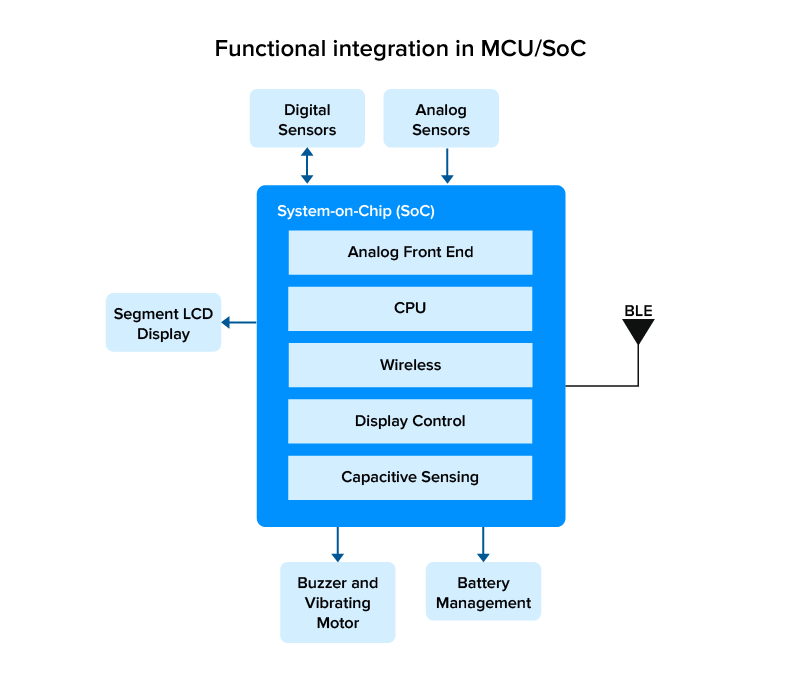
5. Prototyping and UX Optimization
Given the smaller screen sizes and limited battery life of wearables, designing an efficient and user-friendly interface is critical. Prototyping helps validate design concepts, optimize data presentation, and refine the user experience before full-scale development. A minimal, intuitive interface ensures users can interact with the app efficiently without unnecessary complexity.
6. Glanceability
Wearable apps are designed for quick interactions, which means information should be presented in a glanceable format. Unlike smartphones, which allow extended engagement, wearables require minimal yet meaningful data display. For instance, fitness trackers often use simple visuals like lights or icons to convey essential information instantly.
7. Context Awareness
Wearable apps rely on contextual awareness to deliver relevant and timely insights. Since these devices have various sensors, the app must process real-time data efficiently and provide users with actionable information based on their surroundings and activities. A context-driven approach enhances usability and personalization.
8. Cross-Device Compatibility
A seamless user interface is crucial for wearable apps, ensuring smooth integration with existing devices like smartphones and tablets. While wearables collect data, more detailed reviews and analytics often occur on companion devices. For instance, a smartwatch blood pressure monitor and heart health app might gather information/data, but users analyze trends and reports through a smartphone.
Wearable App Development Process – A Step-by-Step Guide
Developing a wearable app requires a well-thought-out strategy that aligns with both the unique functionality of wearable devices and the needs of your target users. The process involves multiple steps, from conceptualizing an idea to final testing and maintenance, each essential for creating an effective app experience. Let’s walk through each stage of wearable app development, uncovering how to turn a wearable app concept into a seamless reality.
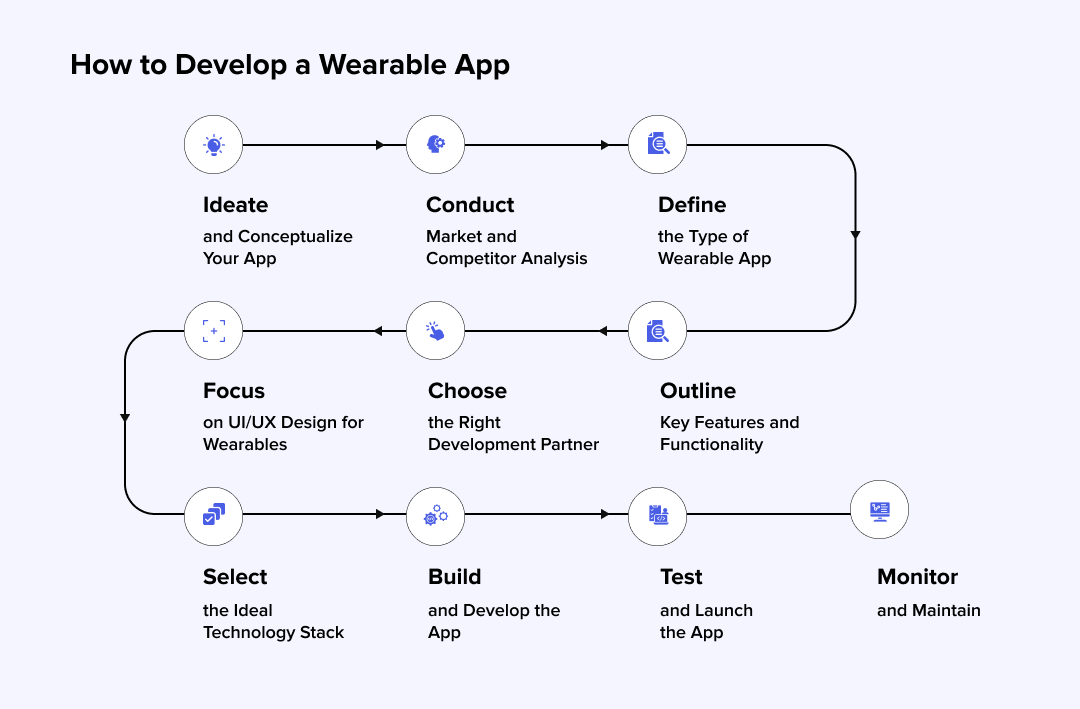
Ideate and Conceptualize Your App
The first step in the wearable app development process is to define the concept of your project. Consider the problems you want to solve or the unique value you want to offer users. This could be anything from a fitness tracker to a medical device monitor or even an entertainment app. It’s essential to align the app idea with the needs of your target audience.
Conduct Market and Competitor Analysis
Conduct thorough market research to identify gaps in the wearable tech industry. Study your competitors to understand their strengths and weaknesses. This will help you refine your app idea, ensuring it stands out in the marketplace.
Choose the Type of Wearable App Development
Wearables can be classified into different types, such as standalone apps and companion apps. Decide which category your app will belong to and how it will interact with the wearable device. Consider whether the app will work standalone or integrate with other devices like smartphones.
Outline Key Features and Functionalities
Make a list of essential features your wearable app must have. Prioritize user-centric features, such as real-time data syncing, health tracking, notifications, and personalization, ensuring that they align with the needs of your target audience.
Choose the Right Development Partner
Partner with an experienced wearable app development company that understands the unique challenges of building apps for wearable devices. A well-experienced team can help you with each stage of the wearable app development process and even beyond. What’s more? They also help you navigate the complexities of hardware integration, security adherence, performance optimization, and user experience.
Craft Intuitive UI/UX Design for Wearables
Crafting an intuitive UI/UX is essential for the success of any app development project, and wearable apps are no exception. Since the screen size of wearable devices is limited, your focus should be simplicity, intuitive design, and ease of use. Make sure that the interface is user-friendly and ensures smooth navigation. The design should adapt well to the specific device, whether a smartwatch, fitness tracker, or smart glasses.
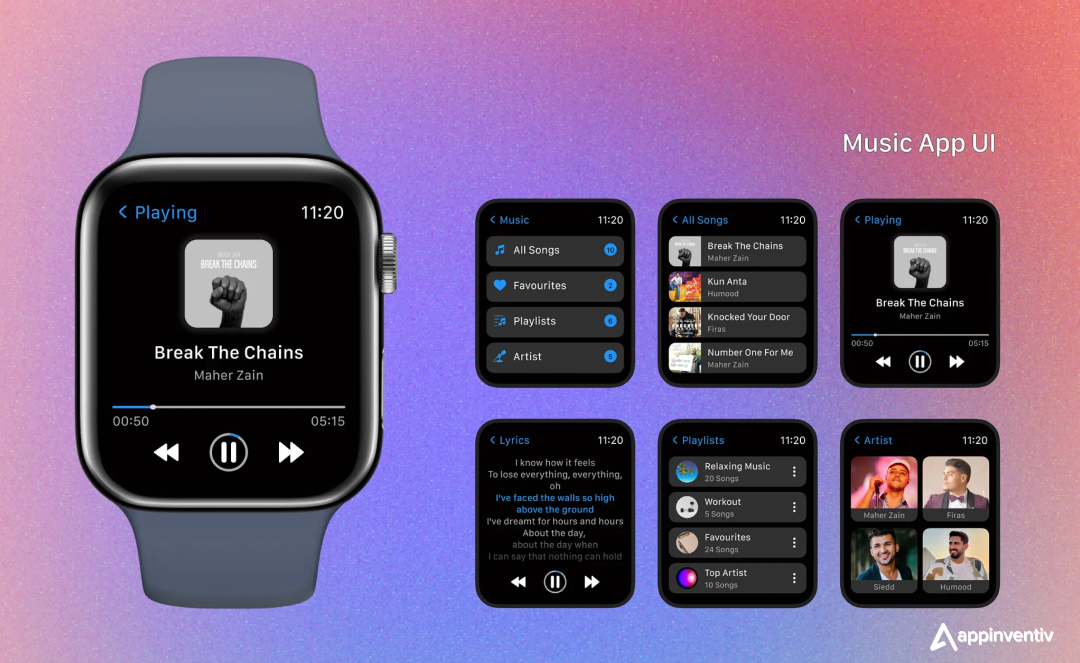
Select the Ideal Technology Stack
Selecting the right technology stack is key to successful wearable app development. Choose programming languages, frameworks, and optimized platforms for wearable devices. Here is a table outlining the key tech stacks for wearable application development.
| Platform | Programming Language | Integrated Development Environment (IDE) |
|---|---|---|
| Android Wear | Java, Kotlin | Android Studio |
| watchOS | Swift, Objective-C | Xcode |
| Google Glass | Java, Cloud-based | Android Studio |
| Samsung Gear (Tizen) | C, C++, JavaScript | Tizen SDK |
| Garmin Wearables | C, C++ | Garmin Connect IQ SDK |
| Fitbit OS | JavaScript, Node.js | Fitbit Studio |
| Microsoft Band | C# | Visual Studio |
Build and Develop the App
The development phase involves building the app’s core functionality, integrating sensors, and processing real-time data. Focus on performance, battery efficiency, and connectivity (Bluetooth, Wi-Fi). Your app should be able to sync seamlessly with the wearable device, whether it’s monitoring health data or providing notifications.
Test and Launch the App
Testing is critical to ensure the app works across wearable devices and platforms. Perform extensive testing for functionality, performance, security, and user experience. After iterative testing, you can launch the app in the market.
Monitor and Maintain
However, the wearable device app development process does not end at deployment; it is an ongoing process that requires continuous monitoring and maintenance. Regular updates and maintenance are essential to keep the app up-to-date with new features and wearable technology advancements.
Also Read: Top 8 tips for wearable app development
How Much Does It Cost To Build a Wearable App?
There is no one-size-fits-all approach to how much it costs to build a wearable app, as the development cost varies based on several key components. Factors such as app features, chosen tech stack, the platform (watchOS, Wear OS, or custom solutions), geographical location of wearable app developers, etc., significantly influence the final cost of wearable application development. Additionally, costs can vary based on the intricacies of UI/UX, backend infrastructure, third-party API integrations, and post-launch maintenance.
On average, wearable app development costs range from $30,000 to $300,000 and above based on your unique project requirements.
For instance, a simple fitness tracking app with basic functionalities will cost less than a fully integrated healthcare wearable app with AI-driven analytics and real-time data synchronization.
Here is a table outlining the wearable app development cost and timelines based on the products’ complexity:
| App Complexity | Average Cost | Average Timeline |
|---|---|---|
| Basic wearable app with essential features | $30,000-$50,000 | 4-6 months |
| Moderately complex app with advanced functionalities | $50,000-$120,000 | 4-9 months |
| Highly complex system with cutting-edge features | $120,000-$300,000 or more | 9 months to 1 year or more |
Challenges of Wearable App Development and How to Overcome Them
Developing a wearable app requires overcoming multiple challenges related to battery efficiency, data security, and seamless user experience. Here is a quick look at some major challenges in wearable app development and effective strategies to overcome them.
1. Limited Screen Space
Setback: Wearable devices have small screens, making displaying detailed information intimidating. Users expect quick access to relevant data without much scrolling or navigation.
Solution: Opt for a minimalist design approach with clear, glanceable content. Prioritize key functionalities and integrate voice commands to enhance user experience.
2. Battery Consumption
Setback: Continuous sensor tracking and real-time data synchronization drain battery life quickly. Unlike smartphones, wearable devices have short battery life, which makes power efficiency a serious concern.
Solution: Wearable app developers should Utilize energy-efficient communication protocols like BLE, implement low-power algorithms, optimize background processes, and reduce the frequency of sensor data collection when not needed. These power management techniques will help extend battery life.
3. Multi-Device Compatibility
Setback: Wearable apps must communicate with multiple device platforms like smartphones, tablets, cloud services, and IoT ecosystems. Ensuring smooth integration across various platforms can be challenging due to varying operating systems.
Solution: Use cross-platform development frameworks such as Flutter or React Native to ensure broad compatibility. To facilitate seamless connectivity, leverage standardized APIs and SDKs provided by watchOS, Wear OS, Tizen, etc..
4. Data Security and Privacy Risks
Setback: Wearable apps collect sensitive user data, including health metrics, location tracking, and biometric authentication. Thus, a minor security vulnerability can lead to serious data breaches. This raises issues related to data privacy and compliance with regulations like GDPR and HIPAA.
Solution: Implement strong security measures like multi-factor authentication and biometric and encryption techniques for data transmission and storage. Follow relevant regulatory guidelines to ensure compliance and build user trust in data privacy.
What is the Future of Wearable App Development?
- The wearable technology market is experiencing rapid growth, with an estimated CAGR of 18% from 2021-2026. The market is expected to reach $265.4 billion by 2026, with a notable rise in sectors such as fitness and healthcare, which is projected to grow 11.2% from 2024 to 2033.
- Changing consumer behavior indicates that approximately 29% of global consumers own at least one wearable device, highlighting the integration of these technologies into daily life.
- Deloitte’s research indicates a growing adoption of wearable device apps. Approximately 60% of US consumer households own a wearable device, and 42% of them are willing to share health data with grocers for personalized food recommendations.
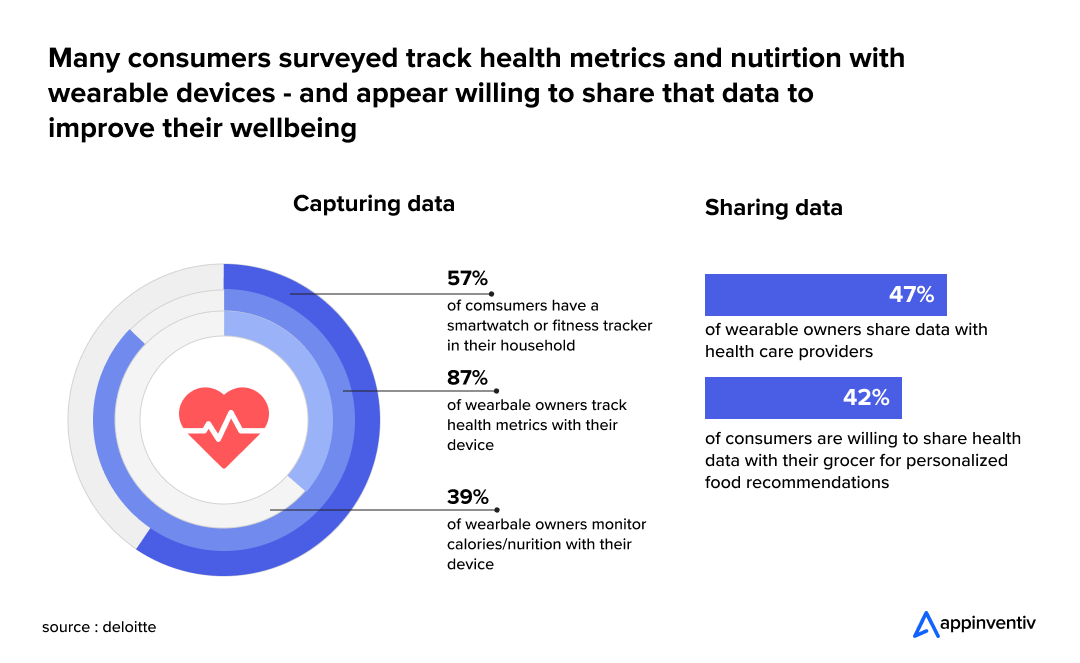
This growth trend in wearable app development offers many opportunities for businesses across industries. It is obvious that companies that win to adapt to this burgeoning market trend will be well-positioned to thrive in this competitive landscape.
How Can Appinventiv Help You With Wearable App Development?
As businesses across industries advance into trending tech wearable app development, keeping pace with the competition requires more than an app; it needs an innovative, user-centric, and high-performing solution. To make that happen, you can count on Appinventiv, a trusted wearable app development company that will turn your vision into intuitive, immersive, and future-ready wearable experiences.
Whether it is fitness, medical, lifestyle, gaming, or utilities, our team of 1600+ tech experts specializes in crafting advanced wearable apps that feel natural to your users and deliver an impeccable experience
Our suite of wearable app development services includes:
- Custom wearable app development
- Multi-platform integration
- Wearable UI/UX design
- End-to-End deployment
- App Maintenance and more
Whether it’s a smartwatch app, fitness tracker, or augmented reality solution, whatever your vision, we bring it to life!
So what are you waiting for? Get in touch with our experts to get started.
FAQs
Q. What is a wearable app?
A. A wearable app is a software application designed to operate on wearable devices such as smartwatches, fitness trackers, smart glasses, headsets, smart clothing, or jewelry. These apps provide users with real-time information and functionalities tailored to wearable technology’s compact and often hands-free nature. They are typically equipped with multiple sensors, allowing users to track their physical activities, health data, and location.
Q. What are some popular real-life examples of wearable apps?
A. Spotify, Google Maps, Uber, Google Keep, Amazon Pay, Google Pay, Fitbit, Headspace, Google Fit, and Strava are the top examples of wearable applications that have gained immense popularity in their respective industries.
Q. What is the significance of healthcare wearable device app development?
A. Healthcare wearable app development has a crucial significance in the medical world. For instance:
- Glucose monitors allow patients to track their glucose levels without frequent finger pricks.
- Wearable blood pressure monitors enable users to track their blood pressure regularly.
- Various diagnostic trackers can identify muscle activity, body temperature, chronic diseases, etc.
- ECG devices can detect irregular heart rhythms, aiding in diagnosing conditions like atrial fibrillation early and potentially preventing serious cardiac events.
- Fitness Trackers like Fitbit track physical activity, heart rate, and sleep patterns, encouraging users to maintain a healthy lifestyle.
Q. How to create a wearable app?
A. Wearable app development is a complex and challenging process. Here is a step-by-step process for creating a wearable app.
- Ideate and Conceptualize Your App
- Conduct Market and Competitor Analysis
- Define the Type of Wearable App
- Outline Key Features and Functionality
- Choose the Right Development Partner
- Focus on UI/UX Design for Wearables
- Select the Ideal Technology Stack
- Build and Develop the App
- Test and Launch the App
- Monitor and Maintain
To understand these vital steps in-depth, please refer to the above blog.



When it comes to mobile app development, a million-dollar question (sometimes literally) keeps businesses awake at night: How much does it cost to build a mobile app that can compete in today's market? It’s a valid concern, as the cost of creating an app can vary dramatically depending on numerous factors. But here’s the thing—app…

Creating a product that can gain instant traction in the market is seldom a straightforward process. Unclear objectives, vague user personas, inadequate documentation, and a range of other obstacles often impact the progress of ambitious businesses. As a result, about 35% of projects encounter significant setbacks and fail to overcome the challenges of the complex…
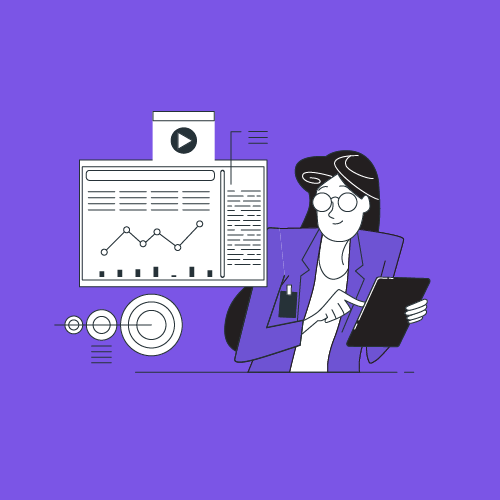
Data science is the domain that couples data-bound analytical techniques along with scientific theories to extract insights for business stakeholders. Its form, factor and magnitude enable businesses to optimize operational fluency, identify new business opportunities, and alleviate the functional performance of departments like marketing and sales. Put simply, data science imparts competitive advantages over rivals…






